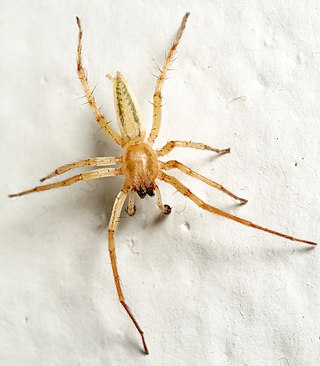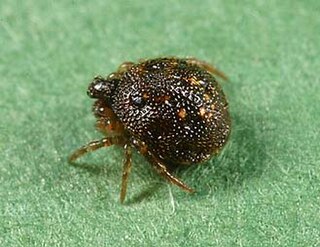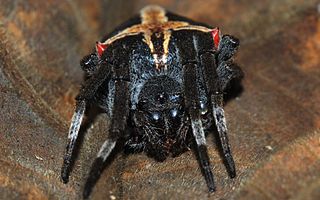
Theridiidae, also known as the tangle-web spiders, cobweb spiders and comb-footed spiders, is a large family of araneomorph spiders first described by Carl Jakob Sundevall in 1833. This diverse, globally distributed family includes over 3,000 species in 124 genera, and is the most common arthropod found in human dwellings throughout the world.

Anyphaenidae is a family of araneomorph spiders, sometimes called anyphaenid sac spiders. They are distinguished from the sac spiders of the family Clubionidae and other spiders by having the abdominal spiracle placed one third to one half of the way anterior to the spinnerets toward the epigastric furrow on the underside of the abdomen. In most spiders the spiracle is just anterior to the spinnerets. Like clubionids, anyphaenids have eight eyes arranged in two rows, conical anterior spinnerets and are wandering predators that build silken retreats, or sacs, usually on plant terminals, between leaves, under bark or under rocks. There are more than 600 species in over 50 genera worldwide.

Argyrodes, also called dewdrop spiders, is a genus of comb-footed spiders that was first described by Eugène Louis Simon in 1864. They occur worldwide, and are best known for their kleptoparasitism. They can spin their own webs, but tend to invade and reside in their hosts' webs. This relationship can be commensal or even mutual if the dewdrop spider feeds on small trapped insects that are not eaten by the host. Some species can even prey upon the host.

Micrathena, known as spiny orbweavers, is a genus of orb-weaver spiders first described by Carl Jakob Sundevall in 1833. Micrathena contains more than a hundred species, most of them Neotropical woodland-dwelling species. The name is derived from the Greek "micro", meaning "small", and the goddess Athena.

Theridion is a genus of tangle-web spiders with a worldwide distribution. Notable species are the Hawaiian happy face spider (T. grallator), named for the iconic symbol on its abdomen, and T. nigroannulatum, one of few spider species that lives in social groups, attacking prey en masse to overwhelm them as a team.

Chrysso is a genus of comb-footed spiders that was first described by Octavius Pickard-Cambridge in 1882.

Thwaitesia is a genus of comb-footed spiders that was first described by Octavius Pickard-Cambridge in 1881.

Anelosimus is a cosmopolitan genus of cobweb spiders (Theridiidae), currently containing 74 species. Anelosimus is a key group in the study of sociality and its evolution in spiders. It contains species spanning the spectrum from solitary to highly social (quasisocial), with eight quasisocial species, far more than any other spider genus. Among these is the South American social species Anelosimus eximius, among the best studied social spider species.

Cryptachaea is a genus of spiders in the Theridiidae family.

Ariamnes is a genus of comb-footed spiders that was first described by Tamerlan Thorell in 1869. Some species have greatly elongated abdomens, making them resemble a twig.

Euryopis is a genus of comb-footed spiders that was first described by Anton Menge in 1868.

Dipoena is a genus of tangle-web spiders that was first described by Tamerlan Thorell in 1869.

Phoroncidia is a genus of comb-footed spiders that was first described by J. O. Westwood in 1835.

Parawixia is a genus of orb-weaver spiders first described by F. O. Pickard-Cambridge in 1904. Most species are found in the Neotropics but one species, Parawixia dehaani, is found in Australasia and tropical Asia as far west as India.

Eustala is a genus of orb-weaver spiders first described by Eugène Simon in 1895.
Ameridion is a genus of comb-footed spiders that was first described by J. Wunderlich in 1995. Species of this genus are found in Mexico, Central America, Northern South America and the West Indies.

Faiditus is a genus of comb-footed spiders that was first described by Eugen von Keyserling in 1884.
Neopisinus is a genus of comb-footed spiders that was first described by M. A. L. Marques, E. H. Buckup & E. N. L. Rodrigues in 2011.

Neospintharus is a genus of comb-footed spiders that was first described by H. Exline in 1950. It was synonymized with Argyrodes in 1962, but revalidated in 2004.

Thymoites is a genus of comb-footed spiders that was first described by Eugen von Keyserling in 1884.

















